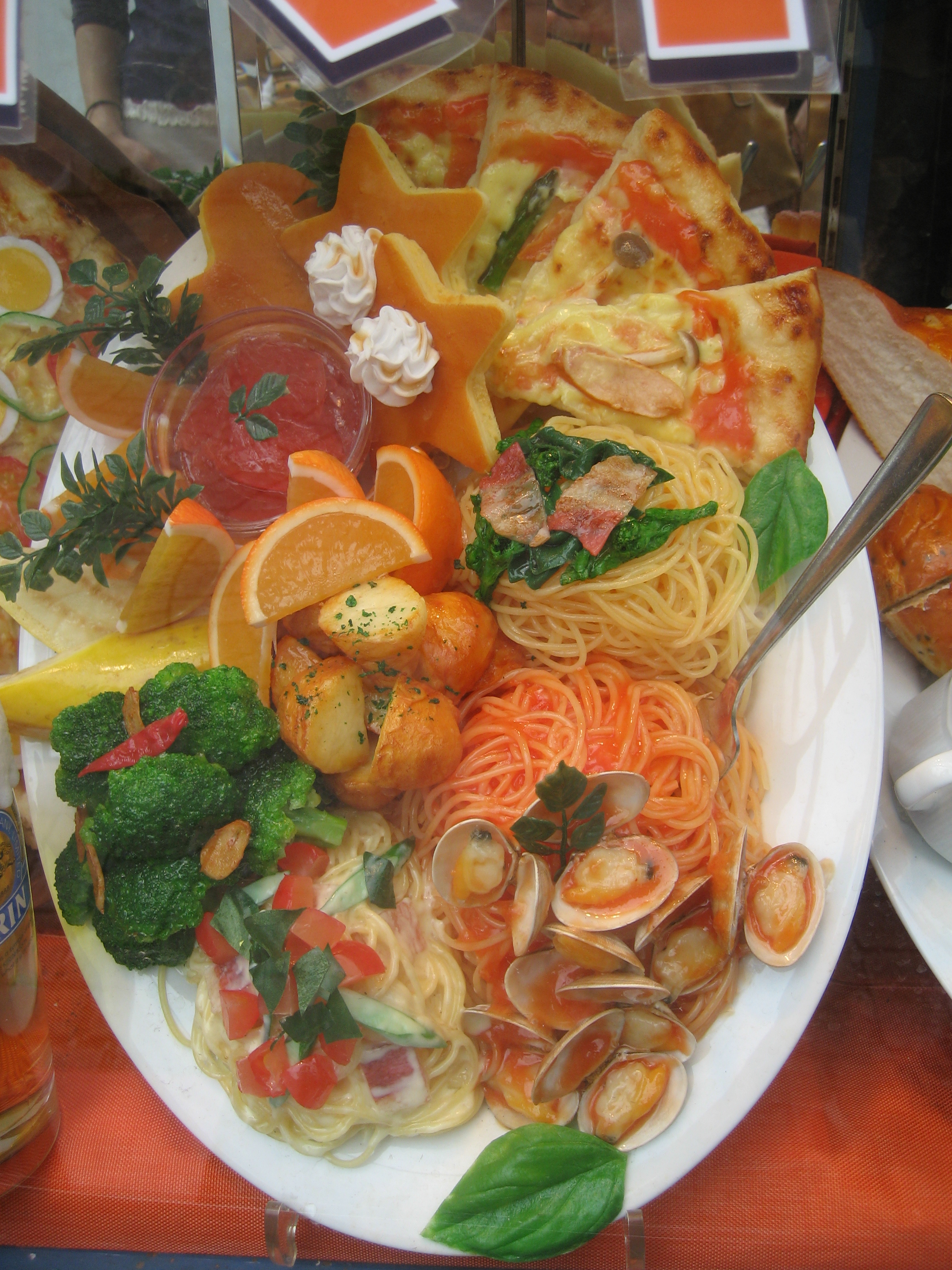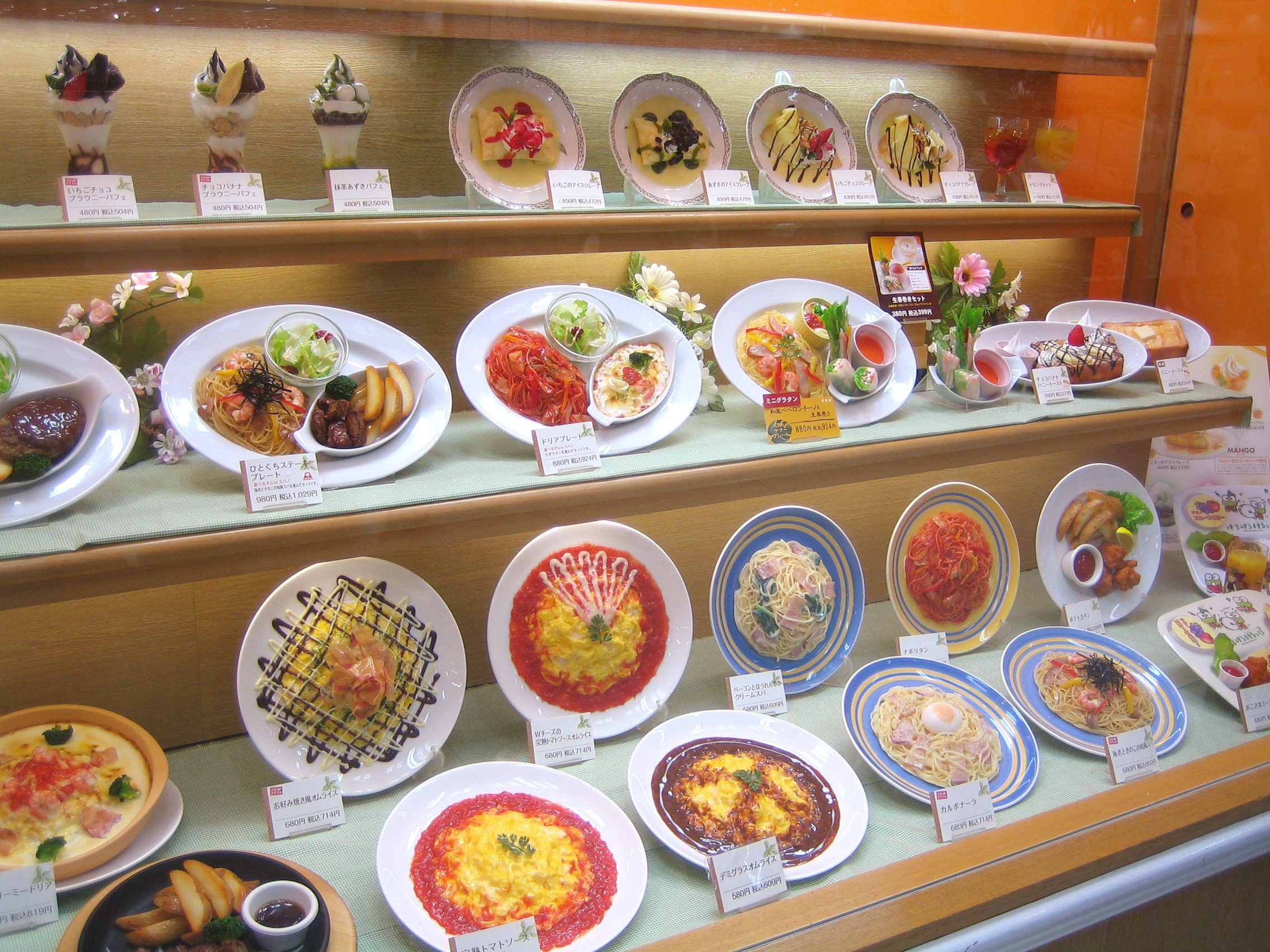Plastic fruit on:
[Wikipedia]
[Google]
[Amazon]
 Food models (''shokuhin sampuru''), also known as fake foods or food samples are a model or replica of a food item made from plastic, wax, resin or similar material. These models are commonly used in restaurant street displays in
Food models (''shokuhin sampuru''), also known as fake foods or food samples are a model or replica of a food item made from plastic, wax, resin or similar material. These models are commonly used in restaurant street displays in
 In Japan, , taken from the English "sample", are widespread. In the late
In Japan, , taken from the English "sample", are widespread. In the late
 Fake and replica foods are used in many ways, such as
Fake and replica foods are used in many ways, such as
Japan
Japan ( ja, 日本, or , and formally , ''Nihonkoku'') is an island country in East Asia. It is situated in the northwest Pacific Ocean, and is bordered on the west by the Sea of Japan, while extending from the Sea of Okhotsk in the n ...
to represent the dishes available inside.
Use by Japanese restaurants
 In Japan, , taken from the English "sample", are widespread. In the late
In Japan, , taken from the English "sample", are widespread. In the late Edo period
The or is the period between 1603 and 1867 in the history of Japan, when Japan was under the rule of the Tokugawa shogunate and the country's 300 regional '' daimyo''. Emerging from the chaos of the Sengoku period, the Edo period was character ...
, in the 1800s, food sellers displayed a plate of real food each day in lieu of a written menu. During the early Shōwa period
Shōwa may refer to:
* Hirohito (1901–1989), the 124th Emperor of Japan, known posthumously as Emperor Shōwa
* Showa Corporation, a Japanese suspension and shock manufacturer, affiliated with the Honda keiretsu
Japanese eras
* Jōwa (Heian ...
, in the late 1920s, Japanese artisans
An artisan (from french: artisan, it, artigiano) is a skilled craft worker who makes or creates material objects partly or entirely by hand. These objects may be functional or strictly decorative, for example furniture, decorative art, ...
and candle
A candle is an ignitable wick embedded in wax, or another flammable solid substance such as tallow, that provides light, and in some cases, a fragrance. A candle can also provide heat or a method of keeping time.
A person who makes candle ...
makers developed food models that made it easy for patrons to order without the use of menus, which were not common in Japan at that time. Paraffin was used to create these until the mid-1980s, but because its colors faded when exposed to heat or sunlight, manufacturers later switched to polyvinyl chloride, which is "nearly eternal".
The plastic model
:''In art and architecture, plastic model may also be any three-dimensional physical model, regardless of material.''
:''In mechanical engineering, a plastic model is a mathematical model of a material which incorporates plasticity.''
300px, A 4-y ...
s are mostly handmade from polyvinyl chloride and sculpted to look like the actual dishes. The models can be custom-tailored to individual restaurant
A restaurant is a business that prepares and serves food and drinks to customers. Meals are generally served and eaten on the premises, but many restaurants also offer take-out and food delivery services. Restaurants vary greatly in appearan ...
s and even common items such as ramen
is a Japanese noodle dish. It consists of served in a broth; common flavors are soy sauce and miso, with typical toppings including , nori (dried seaweed), menma (bamboo shoots), and scallions. Ramen has its roots in Chinese noodle di ...
can be modified to match each establishment's food or regional differences. During the molding process, the imitation ingredients are often chopped up and combined in a manner similar to actual cooking.
Many restaurants in Japan use replicas to display their popular dishes in their windows and attract customers. The plastic food manufacturers fiercely guard their trade secrets as business is lucrative; the plastic food industry in Japan, by conservative estimates, has revenues of billions of yen per year. A single restaurant may order a complete menu of plastic items costing over a million yen (equivalent to about 7,900 Euros or US$ 9,600). The plastic replicas are much more expensive than the food they imitate, but can last indefinitely. For this reason, many companies that manufacture fake food have stagnant or declining profits. Because some individual pieces can be very expensive, sometimes restaurants rent the pieces instead of buying them outright. They are also sold to the general public in some retail stores in Tokyo's "Kitchen Town" restaurant supply district.
The craftsmanship has been raised to an art form. Japanese plastic food models by the Maizuru Company were exhibited at London's Victoria and Albert Museum
The Victoria and Albert Museum (often abbreviated as the V&A) in London is the world's largest museum of applied arts, decorative arts and design, housing a permanent collection of over 2.27 million objects. It was founded in 1852 and nam ...
in 1980. Regular competitions are held in making fake food dishes out of plastic and other materials.
Other uses
props
A prop, formally known as (theatrical) property, is an object used on stage or screen by actors during a performance or screen production. In practical terms, a prop is considered to be anything movable or portable on a stage or a set, distinc ...
for backgrounds in movies, television shows, theatrical plays, television commercials, print ads, and trade shows. Food models are also used to display lifelike replicas of real foods for restaurants, grocery chains, museums, banquet halls, casino buffets, cruise ships, and in many other instances in which real foods cannot be displayed. For instance, the American company Fake Foods began when fast food restaurants Wendy's
Wendy's is an American international fast food restaurant chain founded by Dave Thomas (1932–2002) on November 15, 1969, in Columbus, Ohio. Its headquarters moved to Dublin, Ohio, on January 29, 2006. As of December 31, 2018, Wendy's was ...
needed artificial kale
Kale (), or leaf cabbage, belongs to a group of cabbage (''Brassica oleracea'') cultivars grown for their edible leaves, although some are used as ornamentals. Kale plants have green or purple leaves, and the central leaves do not form a hea ...
for their salad bar display.
In the 2010s, models of foods and dishes were also used for nutrition education and consumer research.
In North America, fake food is often used for retail displays. Furniture retailers use it in showrooms (such as a bowl of fake apples) to give their furniture settings a lived-in look.
Sometimes at wedding
A wedding is a ceremony where two people are united in marriage. Wedding traditions and customs vary greatly between cultures, ethnic groups, religions, countries, and social classes. Most wedding ceremonies involve an exchange of marriage vo ...
s, the bride and groom opt to have an elaborately decorated dummy wedding cake
A wedding cake is the traditional cake served at wedding receptions following dinner. In some parts of England, the wedding cake is served at a wedding breakfast; the 'wedding breakfast' does not mean the meal will be held in the morning, but ...
for show while everyone is served slices of sheet cake
A sheet cake or slab cake is a cake baked in a large, flat, rectangular cake pan. Sheet cakes are usually 2 inches deep, although they are sometimes 3 inches deep. These single-layer cakes are frequently frosted, with decorations and ornamental ...
.
Manufacturing process
Modern manufacturing technologies and high quality plastic materials provide realistic-looking fake food replicas, but approximately 95% of all fake food is still handcrafted. Artisans and highly trained craftsmen make realistic fake food, often painting them by hand to create a realistic look and feel. When fake food is made using a mold, the mold is created by dipping real food into silicone. A liquid plastic, typically polyvinyl chloride, is chosen in a color that matches the food, before being poured into the mold and heated in an oven until it solidifies. (When a food sample is not available or would disintegrate or melt in the mold during casting, a clay model of the food must instead be sculpted.) After setting for ten to thirty minutes, any excess vinyl buildup is trimmed off, and the replica is painted either by hand orairbrush
An airbrush is a small, Pneumatics, air-operated tool that Atomizer nozzle, atomizes and sprays various media, most often paint but also ink and dye, and Foundation (cosmetics), foundation. Spray painting developed from the airbrush and is c ...
. If the food comprises several parts, such as a hamburger or sushi roll, the item is assembled from separate vinyl pieces.
While some large-scale fake food manufacturing companies exist, others are small shops with a single proprietor. Fake food items can be found and purchased in Kappabashi-dori
Kappabashi-dori, also known just as Kappabashi ( ja, 合羽橋) or Kitchen Town, is a street in Tokyo between Ueno and Asakusa which is almost entirely populated with shops supplying the restaurant trade. These shops sell everything from knives a ...
, the food supply street in Tokyo
Tokyo (; ja, 東京, , ), officially the Tokyo Metropolis ( ja, 東京都, label=none, ), is the capital and largest city of Japan. Formerly known as Edo, its metropolitan area () is the most populous in the world, with an estimated 37.46 ...
and also at Doguyasuji located in Namba
is a district of Osaka, Japan. It is located in Chūō and Naniwa wards. Namba is regarded as the center of so-called ''Minami'' ("South") area of Osaka. Its name is one of variations on the former name of Osaka, '' Naniwa''. Namba is be ...
, Osaka. Factories can be found in Gujō, Gifu
is a city located in the south-central portion of Gifu Prefecture, Japan, and serves as the prefectural capital. The city has played an important role in Japan's history because of its location in the middle of the country. During the Sengoku p ...
. Iwasaki Be-I is the biggest plastic food manufacturer in Japan, founded by Takizo Iwasaki in 1932. Maiduru is another old and large manufacturer.
See also
*Adulterant
An adulterant is caused by the act of adulteration, a practice of secretly mixing a substance with another. Typical substances that are adulterated include but are not limited to food, cosmetics, pharmaceuticals, fuel, or other chemicals, that ...
References
{{Authority control Food retailing Imitation foods Japanese inventions Artificial objects Advertising